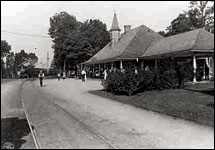MLUI / Articles from 1995 to 2012 / How Petoskey’s Visionary Founder Got It Right
How Petoskey’s Visionary Founder Got It Right
 | |
| MLUI | |
Petoskey's train station, circa 1880. |
In the fall of 1871, as survivors sifted through the ashes of the Great Chicago Fire, large freighters steamed north from that ruined city searching for lumber to rebuild the fallen Windy City. One town freighters visited was on a beautiful Lake Michigan inlet called Petit Traverse Bay, or Little Traverse Bay. Named after Ottawa Chief Ignatius Petosega, Petoskey quickly bloomed into a port community.
As ships and passenger trains brought thousands of visitors from Indianapolis, Cincinnati, Chicago, Detroit, and elsewhere, news of the lovely coastal village spread; soon, many people wanted to move to this place of sparkling water and fresh air. Petoskey was forced to think about how it should grow.
It fell to entrepreneur and financier Hiram Rose to summon the vision and passion to design Petoskey. Mr. Rose had made his money during the gold rush and was eyeing Upper Peninsula copper when he discovered something even more valuable—a community with gorgeous assets but little vision.
How could a place with majestic cliffs, a beautiful bay, and rolling hills not have a plan? Mr. Rose decided to invest in Petoskey’s huge potential and start planning the town.
He knew it must include a well-connected street system, a commercial area and, an easy walk away, homes in a variety of sizes and architectural styles. He imagined villagers strolling from homes to the town center to work, socialize, buy goods, and catch trains to Harbor Springs, Detroit, or Chicago.
So Mr. Rose helped the citizens develop a master plan that established a “walkable” street grid and allowed “mixed uses” that included homes, stores, schools, and churches. He included “transit-oriented development” by integrating the existing rail infrastructure into the pedestrian-friendly village. Those steps helped Petoskey accommodate residential, commercial, and institutional construction and become a vibrant community.
By 1882 there were 13 new mixed-use buildings in the new town center, as well as new homes and a Methodist resort village, now known as Bay View, all close to the train station and to each other. Almost 150 years later, Petoskey remains a well-planned community, one that defines the quintessentially charming, walkable, livable town. It still respects its turn-of-the-century architecture, American-style Main Street, and mixed-use buildings that sit right up against the sidewalk. Petoskey voters’ recent approval of a new, $50 million hotel, housing, and retail development right downtown would probably make Mr. Rose smile, as would the town’s growth, which confirms that his design was a classic one that today’s New Urbanists would approve of in every way.
As Petoskey continues to grow, local historic preservationist Candace Fitzsimmons hopes people remember Hiram Rose’s great foresight and the good things it has brought to her town, which is handling the auto age in fine style.
“Citizens have to continually be educated on why people originally came here, the charm of our towns, the hospitality, and quality of life,” Ms. Fitzsimmons said.





